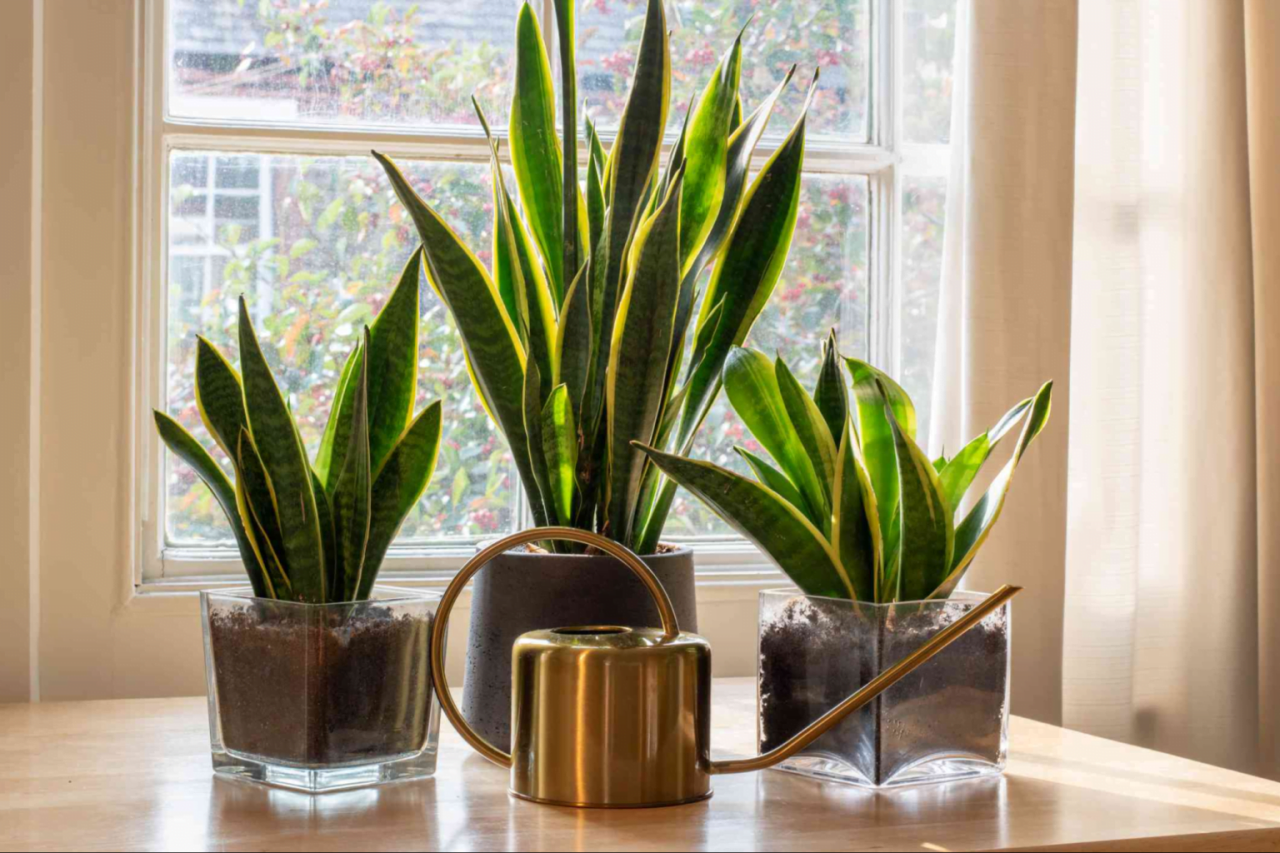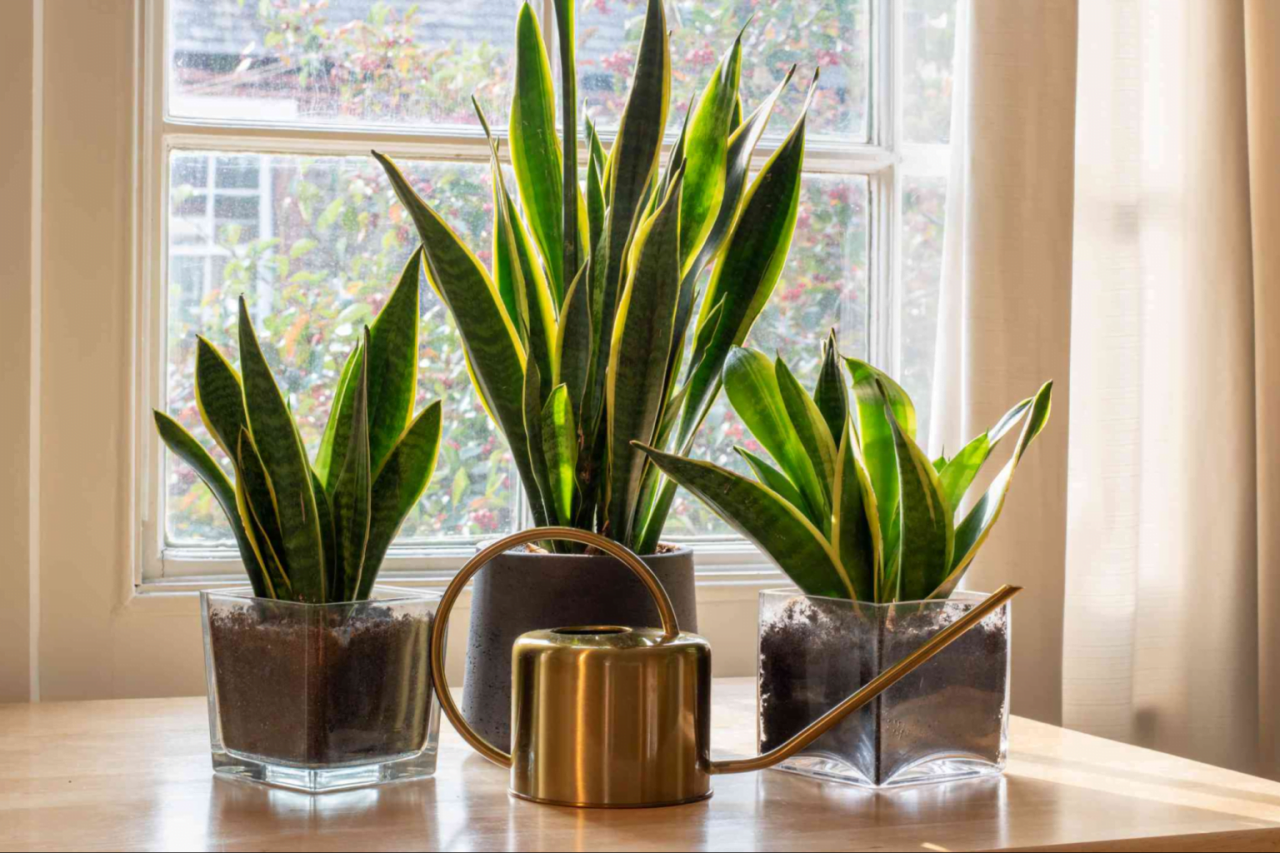Best Watering Tips to Keep Your Snake Plant Thriving is a crucial aspect of ensuring the health and longevity of these resilient houseplants. Snake plants, also known as Sansevieria, are renowned for their ability to thrive in a wide range of conditions, but even these hardy plants require proper watering to flourish.
Understanding their unique water storage capabilities, recognizing signs of overwatering and underwatering, and employing effective watering techniques are essential for maintaining a vibrant and healthy snake plant.
This guide delves into the intricacies of watering snake plants, providing a comprehensive overview of the best practices to keep your snake plant thriving. From understanding their water storage capabilities and the impact of different climates to mastering the “soak and dry” method and recognizing signs of overwatering and underwatering, this guide will equip you with the knowledge and techniques to ensure your snake plant thrives.
Understanding Snake Plant Watering Needs
Snake plants, also known as mother-in-law’s tongue, are incredibly resilient and low-maintenance houseplants, but they still require proper watering to thrive. Understanding their unique water storage capabilities and the impact of climate and seasons on their watering needs is crucial for keeping your snake plant healthy and happy.
Watering Frequency Based on Climate and Season
The frequency of watering your snake plant depends on the climate you live in and the current season. Snake plants are succulents, meaning they have adapted to store water in their leaves. This allows them to tolerate periods of drought and makes them ideal for busy plant parents.
However, even succulents need regular watering to thrive. During the warmer months, when temperatures are high and humidity is low, your snake plant will need more frequent watering. The soil will dry out faster, and the plant will transpire more water through its leaves.
Conversely, during the colder months, when temperatures are lower and humidity is higher, your snake plant will need less frequent watering. The soil will take longer to dry out, and the plant will transpire less water.
The best watering tips for keeping your snake plant thriving revolve around understanding its unique needs. One of the most crucial aspects is to avoid overwatering, which can lead to root rot and damage. To prevent this, it’s essential to allow the soil to dry out completely between waterings.
For a comprehensive guide on how to achieve this without harming your snake plant’s roots, check out this helpful resource: How to Water Snake Plants Without Damaging the Roots. By following these guidelines, you can ensure your snake plant remains healthy and vibrant for years to come.
Watering Frequency Based on Pot Size and Plant Maturity
The size of the pot and the maturity of the plant also influence watering frequency. Smaller pots dry out faster than larger pots, so plants in smaller pots will need more frequent watering. Similarly, younger snake plants are actively growing and will require more water than mature plants.
- Small pot (under 6 inches):Water every 1-2 weeks, depending on the climate and season.
- Medium pot (6-12 inches):Water every 2-3 weeks, depending on the climate and season.
- Large pot (over 12 inches):Water every 3-4 weeks, depending on the climate and season.
The “Soak and Dry” Method
The “soak and dry” method is a popular and effective way to water snake plants. This method involves thoroughly soaking the soil, allowing it to dry out completely between waterings. This approach mimics the snake plant’s natural environment, where they experience periods of drought followed by heavy rainfall.
Determining When the Soil is Completely Dry
To determine when the soil is completely dry, you can use a few methods.
- Finger Test:Insert your finger about 2-3 inches into the soil. If the soil feels dry to the touch, it’s time to water.
- Moisture Meter:A moisture meter can provide a more accurate reading of the soil’s moisture level.
- Weight:A dry pot will feel significantly lighter than a wet pot. Lifting the pot to assess its weight can be a helpful indicator of soil dryness.
Benefits of Allowing the Soil to Dry Out Completely
Allowing the soil to dry out completely between waterings has several benefits for snake plants:
- Prevents Root Rot:Overwatering is a common problem for snake plants, leading to root rot. Allowing the soil to dry out completely helps prevent this issue by ensuring that the roots are not constantly exposed to excessive moisture.
- Promotes Strong Root Development:When the soil dries out, the snake plant’s roots are forced to search for water deeper in the soil, which promotes stronger root growth.
- Reduces the Risk of Pests and Diseases:Dry soil is less hospitable to pests and diseases.
Signs of Overwatering and Underwatering
Understanding the signs of overwatering and underwatering is crucial for maintaining a healthy snake plant. These visual cues will help you identify problems early and adjust your watering practices accordingly.
Just like snake plants, bonsai trees require careful watering to thrive. Overwatering can lead to root rot, while underwatering can cause wilting and stress. The key is to allow the soil to dry out slightly between waterings. And just as the right pot design is crucial for bonsai trees, as outlined in Bonsai Pot Designs: Choosing the Best for Indoor Trees , the correct pot can also influence the success of your snake plant.
Choose a pot with drainage holes to prevent waterlogging and ensure your snake plant receives the ideal amount of moisture.
Signs of Overwatering
Overwatering is a common issue for snake plant owners, often leading to root rot and yellowing leaves. Here are some visual indicators to watch out for:
- Yellowing leaves: Overwatering can cause the leaves to turn yellow, starting at the base and gradually spreading upwards. This is due to the roots being unable to absorb nutrients effectively in waterlogged soil.
- Soft, mushy leaves: When a snake plant is overwatered, the leaves can become soft and mushy, indicating damage to the plant’s tissues.
- Foul odor: Overwatering can create an environment for bacteria and fungi to thrive, leading to a foul odor from the soil.
- Root rot: If you notice the roots are brown, mushy, and have a foul odor, this is a clear sign of root rot, a common consequence of overwatering.
Signs of Underwatering
Underwatering is another common issue that can affect snake plant health. Here are some visual indicators to watch for:
- Wilting leaves: Underwatering causes the leaves to wilt and droop, as the plant struggles to maintain its turgor pressure.
- Dry soil: The soil should be completely dry to the touch before you water your snake plant. If the soil is still moist, it’s not yet time to water.
- Brown tips: Underwatering can cause the tips of the leaves to turn brown and crispy.
- Leaf drop: In severe cases of underwatering, the snake plant may start to drop leaves.
Visual Guide, Best Watering Tips to Keep Your Snake Plant Thriving
To illustrate the differences between healthy snake plants and those experiencing overwatering or underwatering, consider the following:
Healthy Snake Plant: A healthy snake plant has upright, firm leaves with a vibrant green color. The soil is dry to the touch between waterings.
Overwatered Snake Plant: An overwatered snake plant has yellowing leaves, especially at the base. The leaves may be soft and mushy, and the soil may have a foul odor. The roots may be brown and mushy, indicating root rot.
Underwatered Snake Plant: An underwatered snake plant has wilting leaves that are dry and crispy. The soil is completely dry and may be cracked. The tips of the leaves may be brown.
Watering Techniques: Best Watering Tips To Keep Your Snake Plant Thriving
The right watering techniques are crucial for maintaining a healthy and thriving snake plant. While the “soak and dry” method dictates the frequency of watering, proper techniques ensure water reaches the roots effectively without overwatering or causing root rot.
Watering with a Watering Can
Using a watering can is the most common and effective way to water snake plants. It allows for precise control over the amount of water applied.
- Fill the watering can with lukewarm water. Avoid using cold water, as it can shock the plant’s roots.
- Slowly pour water onto the soil, ensuring the entire soil surface is moistened.
- Allow excess water to drain. This is essential to prevent waterlogging and root rot.
Preventing Water Pooling
Water pooling at the base of the snake plant can lead to root rot.
- Ensure the pot has drainage holesto allow excess water to escape.
- Avoid overwatering, as this can lead to water pooling.
- Choose a pot with a wide baseto minimize the risk of water pooling.
Watering in Different Pots
The type of pot used can affect how you water your snake plant.
- Terracotta potsare porous and allow water to evaporate quickly, requiring more frequent watering.
- Plastic potsretain moisture for longer, so watering frequency should be adjusted accordingly.
Additional Watering Considerations
While the “soak and dry” method is a fundamental guideline, several other factors can influence your snake plant’s watering needs. Understanding these factors can help you fine-tune your watering practices for optimal plant health.
Humidity’s Impact on Watering
Humidity, the amount of moisture in the air, plays a significant role in how quickly the soil dries out. High humidity levels slow down evaporation, meaning the soil will remain moist for longer periods. Conversely, low humidity accelerates evaporation, requiring more frequent watering.
Adjusting Watering Schedules for Humidity Variations
- High Humidity:In humid environments, snake plants may need watering less frequently. You can extend the time between waterings, allowing the soil to dry out more thoroughly.
- Low Humidity:In dry environments, your snake plant will likely require more frequent watering to compensate for the increased evaporation rate. You may need to water more often, especially during the hotter months.
Watering Snake Plants in Different Environments
- Indoors:Indoor environments tend to be drier, particularly during winter when heating systems are in use. This can lead to quicker soil drying and the need for more frequent watering.
- Outdoors:Outdoor environments often have higher humidity levels, especially in humid climates. This can extend the time between waterings, allowing the soil to dry out more slowly. However, during hot and dry spells, outdoor snake plants may still require more frequent watering.
Concluding Remarks

By understanding the unique watering needs of snake plants, implementing the “soak and dry” method, and recognizing the signs of overwatering and underwatering, you can create an optimal environment for your snake plant to thrive. With consistent care and attention to its watering needs, your snake plant will reward you with its vibrant foliage and air-purifying qualities for years to come.
Commonly Asked Questions
What type of water is best for snake plants?
Snake plants prefer room temperature water that has been allowed to sit for 24 hours to allow chlorine to dissipate.
Can I use tap water for my snake plant?
While tap water is generally fine, using filtered or distilled water is best, especially if your tap water is hard or contains high levels of minerals.
How often should I fertilize my snake plant?
Snake plants are light feeders and only need fertilization during the growing season (spring and summer). Use a balanced liquid fertilizer diluted to half strength once a month.
What is the best soil for snake plants?
Snake plants thrive in well-draining soil. A cactus potting mix or a combination of potting soil, perlite, and sand is ideal.
